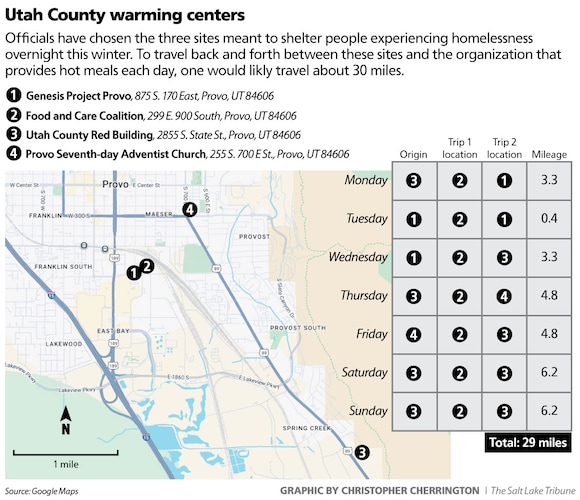Utah County’s plan to offer warm evening shelter to homeless people this winter could compel individuals to make a circuitous, nearly 30-mile trek back and forth each week as they are shuffled to different centers and resources day to day.
The three different centers the county selected to offer overnight services from Oct. 15 through April 20, 2025, sit at varying distances from each other. They include the Genesis Project Provo, 875 S. 170 East (Provo); the Utah County Red Building, 2855 S. State St. (between Provo and Springville); and the Seventh-day Adventist Church, 255 S. 700 East (Provo).
Each center will accommodate up to 75 people and will primarily be used for sleeping. The county will provide housing to parents with children at hotels or other locations.
There were at least 175 people experiencing homelessness in Utah County in January 2024, according to the most recent Point-in-Time Count data.
Brandon Gordon, the Utah County Commissioner who served as a winter response plan task force chair, said in a written statement that state officials set the warming centers’ capacity after much “thought and research.”
“If we reach a full 75 this year,” he said, “that will be more than quadruple what we often saw last year and basically double our highest number last year.”

(Christopher Cherrington | The Salt Lake Tribune)
Those using the centers will be given a sleeping mat, blankets, snacks and drinks, and Utah Transit Authority passes for bus rides to and from the centers, but no warm meals. Gordon encouraged people experiencing homelessness to receive meals at the Food and Care Coalition, at 299 E. 900 South in Provo.
“It’s been very important to us that warming centers complement the services already provided in Utah County,” he said. “The Food and Care Coalition has been providing three warm meals a day for a long time.”
Generally, the Genesis Project Provo will serve as a warming center on Mondays and Tuesdays.
On Wednesdays, the designated center will move to the Utah County Red Building.
Then on Thursdays, the Provo Seventh-day Adventist Church will host the designated warming center before the location switches back to the Red Building on Fridays, where it will remain through Sundays. Centers will be open overnight from 9 p.m. to 8 a.m.
The trips back and forth between the various warming centers and the Food and Care Coalition for meals amounts to traveling around 30 miles every week, according to a Salt Lake Tribune review of the locations.
Gordon told The Tribune in a written response that the task force was comprised of two people who had past or current experiencing being homeless — “and they liked this plan a lot, even with the transit component.”
“Getting comfortable with transit is highly valuable for someone needing services,” Gordon said. “I’m confident in our team of service providers and in UTA that we’re going to do a great job helping people get where they need to be.”
This plan comes after lawmakers passed a bill last year requiring Utah’s most populated counties to create a homeless services and resource blueprint ahead of the winter season every year. Utah County opened warming centers as a pilot program last winter, preparing for the law to go into effect this year.
With the pilot program running, the Provo Police Department tallied one death for a person experiencing homelessness. That man was found dead outside a business on Jan. 10, when the high temperature was 36 degrees, the low was 25, and there was 1.5 inches of snow on the ground.
The year before, when the county wasn’t required to providing warming centers, the Police Department reported that five people experiencing homelessness died. Most, a spokesperson said, were attributed to drugs, alcohol or health conditions. One died from hypothermia.
Gordon characterized the formalized warming centers as the “latest addition” to the county’s “ecosystem of services” that he said had been quietly helping people experiencing homelessness since the ’60s.
Utah County does not host a permanent congregate shelter, though groups like Community Action Services and Food Bank, Wasatch Behavioral Health, the Provo City Housing Authority, The Refuge Utah and the Food and Care Coalition have been providing housing, mental health and food assistance for years.
According to the task force, those groups “evolve[d] organically” and the task force focused on “what seems most effective to them.” So far, according to the task force, those groups have met the need for emergency shelter with hotel and motel vouchers.
In Provo, the county’s most populous city, council members passed an ordinance in 2017 that banned camping.
This summer, some of Provo’s unhoused have been gathering to speak during public comment at City Council meetings to air grievances and their experiences. At the Aug. 20 meeting, a handful of people experiencing homelessness spoke. One man said police officers hassled him whenever he was in city parks, where he said he visited to rest and try to stay cool.
“I don’t know what else to do about it, other than tell them we are allowed here,” he said.
Bonnie Shiffler-Olsen, a homelessness advocate who has been facilitating the mass public comment sessions, also spoke at the meeting. In her brief comments, she thanked council members for passing a tax increase to fund the library — and for the warming centers.
“You guys,” she said, “are great.”
For more information on accessing warming centers, the task force encouraged people to call 211 — “a comprehensive one-stop phone number.” Call 801-441-1993 to confirm which centers are open each night.
(Rick Egan | The Salt Lake Tribune) Homelessness advocate Bonnie Shiffler-Olsen sits with a group of homeless people and advocates in the Provo City Council chambers, Tuesday, July 16, 2024.
Correction • Aug. 31, 2024, 2 p.m.: This story has been updated to reflect Utah County’s most recent Point-in-Time Count data.








